Reading time: 14 min
Hard by a great forest dwelt a wood-cutter with his wife, who had an only child, a little girl three years old. They were so poor, however, that they no longer had daily bread, and did not know how to get food for her. One morning the wood-cutter went out sorrowfully to his work in the forest, and while he was cutting wood, suddenly there stood before him a tall and beautiful woman with a crown of shining stars on her head, who said to him: „I am the Virgin Mary, mother of the child Jesus. Thou art poor and needy, bring thy child to me, I will take her with me and be her mother, and care for her.“ The wood-cutter obeyed, brought his child, and gave her to the Virgin Mary, who took her up to heaven with her.
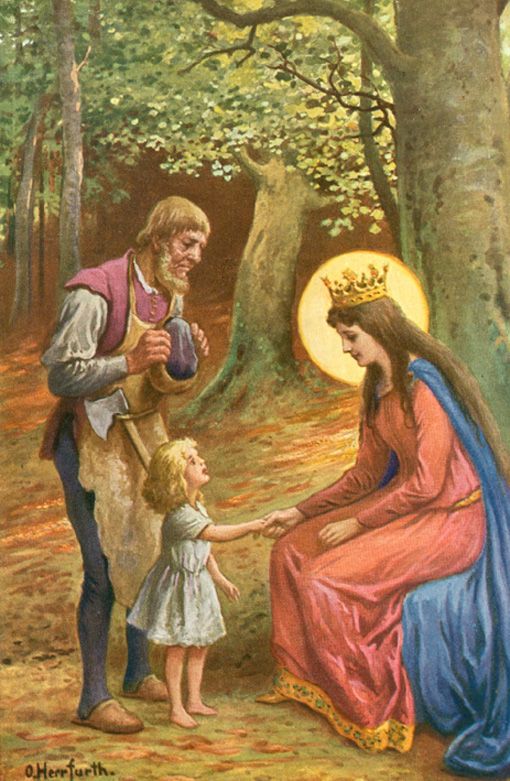 Image: Oskar Herrfurth (1862-1934)
Image: Oskar Herrfurth (1862-1934)There the child fared well, ate sugar-cakes, and drank sweet milk, and her clothes were of gold, and the little angels played with her. And when she was fourteen years of age, the Virgin Mary called her one day and said: „Dear child, I am about to make a long journey, so take into thy keeping the keys of the thirteen doors of heaven. Twelve of these thou mayest open, and behold the glory which is within them, but the thirteenth, to which this little key belongs, is forbidden thee. Beware of opening it, or thou wilt bring misery on thyself.“
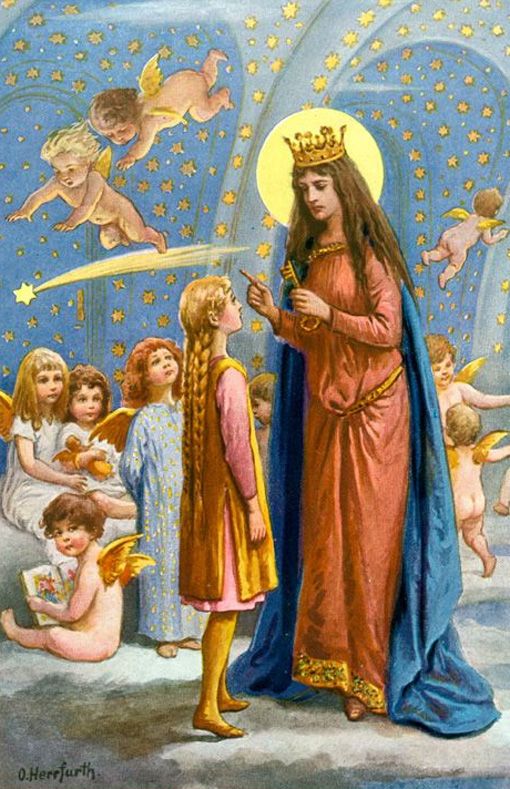 Image: Oskar Herrfurth (1862-1934)
Image: Oskar Herrfurth (1862-1934)The girl promised to be obedient, and when the Virgin Mary was gone, she began to examine the dwellings of the kingdom of heaven. Each day she opened one of them, until she had made the round of the twelve. In each of them sat one of the Apostles in the midst of a great light, and she rejoiced in all the magnificence and splendour, and the little angels who always accompanied her rejoiced with her. Then the forbidden door alone remained, and she felt a great desire to know what could be hidden behind it, and said to the angels: „I will not quite open it, and I will not go inside it, but I will unlock it so that we can just see a little through the opening.“
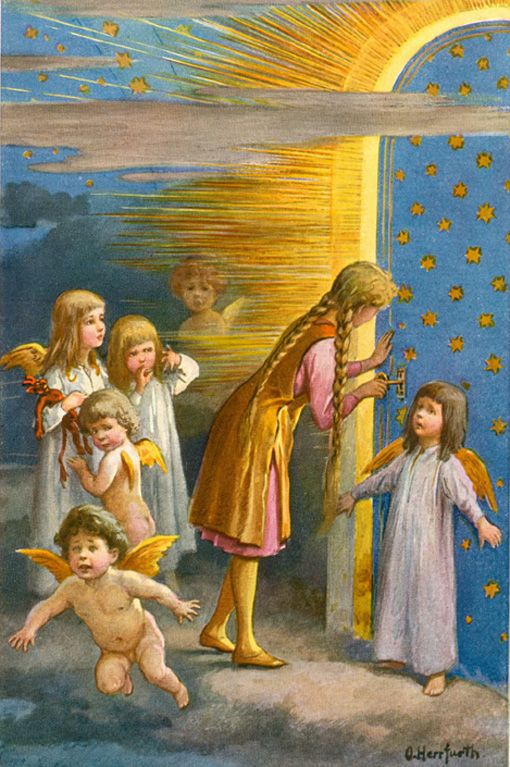 Image: Oskar Herrfurth (1862-1934)
Image: Oskar Herrfurth (1862-1934)„Oh no,“ said the little angels, „that would be a sin. The Virgin Mary has forbidden it, and it might easily cause thy unhappiness.“ Then she was silent, but the desire in her heart was not stilled, but gnawed there and tormented her, and let her have no rest. And once when the angels had all gone out, she thought: „Now I am quite alone, and I could peep in. If I do it, no one will ever know.“ She sought out the key, and when she had got it in her hand, she put it in the lock, and when she had put it in, she turned it round as well.
Then the door sprang open, and she saw there the Trinity sitting in fire and splendour. She stayed there awhile, and looked at everything in amazement. Then she touched the light a little with her finger, and her finger became quite golden. Immediately a great fear fell on her. She shut the door violently, and ran away. Her terror too would not quit her, let her do what she might, and her heart beat continually and would not be still. The gold too stayed on her finger, and would not go away, let her rub it and wash it never so much.
It was not long before the Virgin Mary came back from her journey. She called the girl before her, and asked to have the keys of heaven back. When the maiden gave her the bunch, the Virgin looked into her eyes and said: „Hast thou not opened the thirteenth door also?“ – „No,“ she replied. Then she laid her hand on the girl’s heart, and felt how it beat and beat, and saw right well that she had disobeyed her order and had opened the door. Then she said once again: „Art thou certain that thou hast not done it?“ – „Yes,“ said the girl, for the second time. Then she perceived the finger which had become golden from touching the fire of heaven, and saw well that the child had sinned, and said for the third time: „Hast thou not done it?“ – „No,“ said the girl for the third time. Then said the Virgin Mary: „Thou hast not obeyed me, and besides that thou hast lied, thou art no longer worthy to be in heaven.“
Then the girl fell into a deep sleep, and when she awoke she lay on the earth below, and in the midst of a wilderness. She wanted to cry out, but she could bring forth no sound. She sprang up and wanted to run away, but whithersoever she turned herself, she was continually held back by thick hedges of thorns through which she could not break. In the desert, in which she was imprisoned, there stood an old hollow tree, and this had to be her dwelling-place. Into this she crept when night came, and here she slept.
Here, too, she found a shelter from storm and rain, but it was a miserable life, and bitterly did she weep when she remembered how happy she had been in heaven, and how the angels had played with her. Roots and wild berries were her only food, and for these she sought as far as she could go. In the autumn she picked up the fallen nuts and leaves, and carried them into the hole. The nuts were her food in winter, and when snow and ice came, she crept amongst the leaves like a poor little animal that she might not freeze. Before long her clothes were all torn, and one bit of them after another fell off her. As soon, however, as the sun shone warm again, she went out and sat in front of the tree, and her long hair covered her on all sides like a mantle. Thus she sat year after year, and felt the pain and the misery of the world.
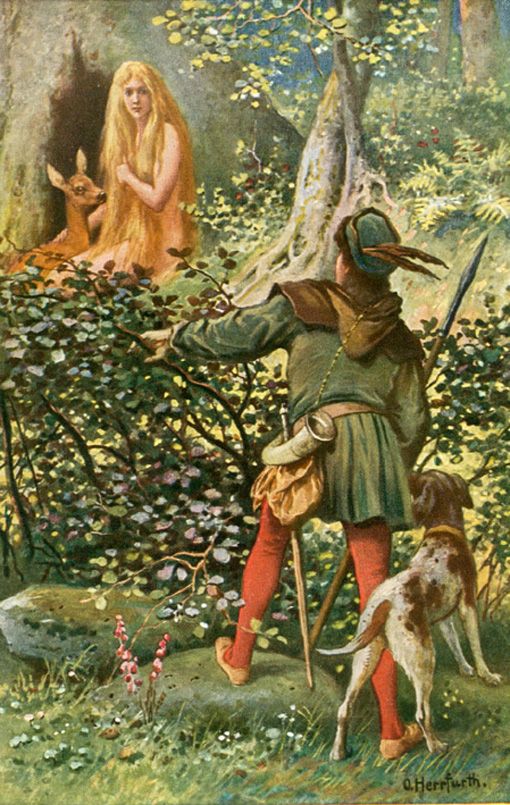 Image: Oskar Herrfurth (1862-1934)
Image: Oskar Herrfurth (1862-1934)One day, when the trees were once more clothed in fresh green, the King of the country was hunting in the forest, and followed a roe, and as it had fled into the thicket which shut in this part of the forest, he got off his horse, tore the bushes asunder, and cut himself a path with his sword. When he had at last forced his way through, he saw a wonderfully beautiful maiden sitting under the tree; and she sat there and was entirely covered with her golden hair down to her very feet.
He stood still and looked at her full of surprise, then he spoke to her and said: „Who art thou? Why art thou sitting here in the wilderness?“ But she gave no answer, for she could not open her mouth. The King continued: „Wilt thou go with me to my castle?“ Then she just nodded her head a little. The King took her in his arms, carried her to his horse, and rode home with her, and when he reached the royal castle he caused her to be dressed in beautiful garments, and gave her all things in abundance. Although she could not speak, she was still so beautiful and charming that he began to love her with all his heart, and it was not long before he married her.
After a year or so had passed, the Queen brought a son into the world. Thereupon the Virgin Mary appeared to her in the night when she lay in her bed alone, and said: „If thou wilt tell the truth and confess that thou didst unlock the forbidden door, I will open thy mouth and give thee back thy speech, but if thou perseverest in thy sin, and deniest obstinately, I will take thy new-born child away with me.“
Then the queen was permitted to answer, but she remained hard, and said: „No, I did not open the forbidden door,“ and the Virgin Mary took the new-born child from her arms, and vanished with it. Next morning when the child was not to be found, it was whispered among the people that the Queen was a man-eater, and had killed her own child. She heard all this and could say nothing to the contrary, but the King would not believe it, for he loved her so much.
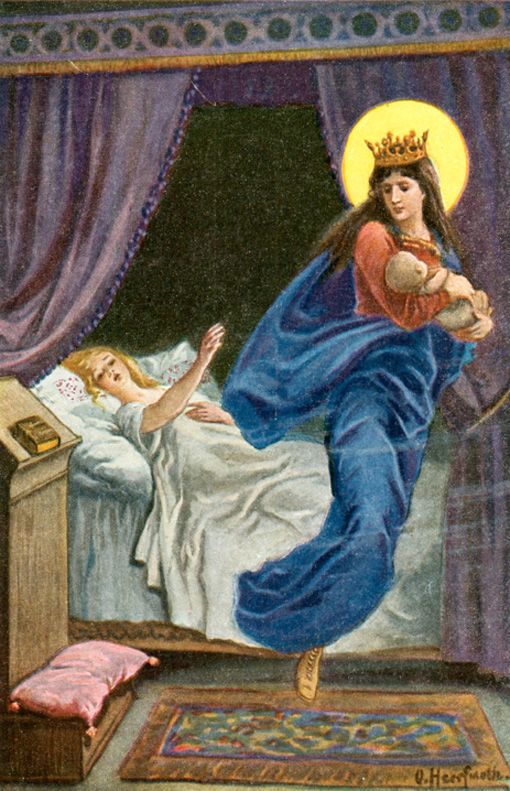 Image: Oskar Herrfurth (1862-1934)
Image: Oskar Herrfurth (1862-1934)When a year had gone by the Queen again bore a son, and in the night the Virgin Mary again came to her, and said: „If thou wilt confess that thou openedst the forbidden door, I will give thee thy child back and untie thy tongue; but if you continuest in sin and deniest it, I will take away with me this new child also.“ Then the Queen again said: „No, I did not open the forbidden door“, and the Virgin took the child out of her arms, and away with her to heaven. Next morning, when this child also had disappeared, the people declared quite loudly that the Queen had devoured it, and the King’s councillors demanded that she should be brought to justice.
The King, however, loved her so dearly that he would not believe it, and commanded the councillors under pain of death not to say any more about it. The following year the Queen gave birth to a beautiful little daughter, and for the third time the Virgin Mary appeared to her in the night and said: „Follow me.“ She took the Queen by the hand and led her to heaven, and showed her there her two eldest children, who smiled at her, and were playing with the ball of the world. When the Queen rejoiced thereat, the Virgin Mary said: „Is thy heart not yet softened? If thou wilt own that thou openedst the forbidden door, I will give thee back thy two little sons.“
But for the third time the Queen answered: „No, I did not open the forbidden door.“ Then the Virgin let her sink down to earth once more, and took from her likewise her third child. Next morning, when the loss was reported abroad, all the people cried loudly: „The Queen is a man-eater. She must be judged,“ and the King was no longer able to restrain his councillors. Thereupon a trial was held, and as she could not answer, and defend herself, she was condemned to be burnt alive.
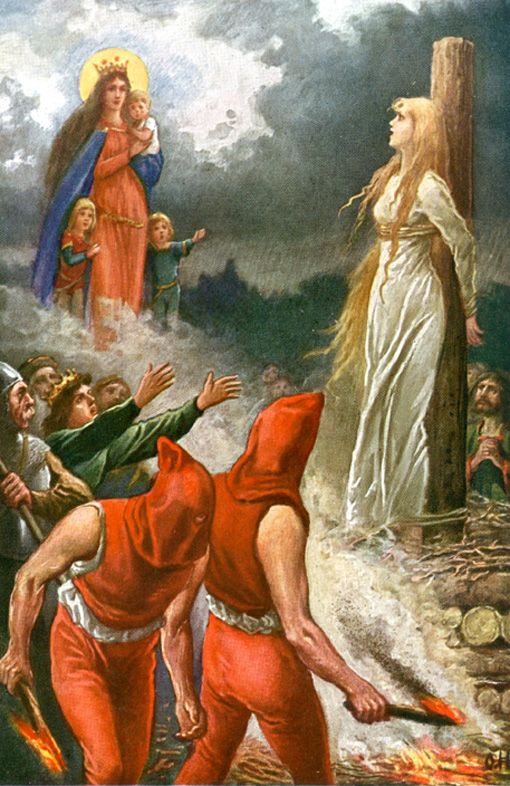 Image: Oskar Herrfurth (1862-1934)
Image: Oskar Herrfurth (1862-1934)The wood was got together, and when she was fast bound to the stake, and the fire began to burn round about her, the hard ice of pride melted, her heart was moved by repentance, and she thought: „If I could but confess before my death that I opened the door.“ Then her voice came back to her, and she cried out loudly: „Yes, Mary, I did it,“ and straight-way rain fell from the sky and extinguished the flames of fire, and a light broke forth above her, and the Virgin Mary descended with the two little sons by her side, and the new-born daughter in her arms. She spoke kindly to her, and said: „He who repents his sin and acknowledges it, is forgiven.“ Then she gave her the three children, untied her tongue, and granted her happiness for her whole life.
 Learn languages. Double-tap on a word.Learn languages in context with Childstories.org and Deepl.com.
Learn languages. Double-tap on a word.Learn languages in context with Childstories.org and Deepl.com.Backgrounds
Interpretations
Adaptions
Summary
Abstract
Linguistics
„Our Lady’s Child,“ also known as „Marienkind“ in German, is a fairy tale collected by the Brothers Grimm in their „Children’s and Household Tales.“ The story, which falls under the Aarne-Thompson-Uther (ATU) classification system as ATU 710 – Our Lady’s Child, has roots in European folklore and religious traditions, particularly those related to the Virgin Mary and Christian beliefs.
The tale revolves around a young girl who is taken in by the Virgin Mary to live with her in heaven. The girl is given the task of guarding a set of keys to thirteen doors, with the warning that she must not open the thirteenth door under any circumstances. Tempted by curiosity, the girl disobeys the instruction and opens the forbidden door. Inside, she finds the Holy Trinity but is also spotted by God. As a result, the girl loses the Virgin Mary’s favor and is cursed with silence, unable to speak.
The girl is eventually sent back to Earth, where she lives a difficult life in the forest. She is found by a king, who falls in love with her and marries her despite her inability to speak. The couple has three children, but each child is taken away by the Virgin Mary shortly after birth. The girl is accused of killing her own children, and, unable to defend herself due to her curse of silence, is sentenced to death.
Just as the girl is about to be executed, the Virgin Mary intervenes, returning the children and lifting the curse of silence. The girl is finally able to tell her story, proving her innocence. The family is reunited, and they live happily ever after. The story of „Our Lady’s Child“ reflects religious themes and moral lessons prevalent in European folklore. The tale emphasizes the importance of obedience, faith, and humility. It also highlights the role of divine intervention and forgiveness in the face of human weakness.
The tale has been passed down through generations, likely dating back to medieval times when religious stories played a significant role in shaping societal values and norms. Its combination of religious themes, moral lessons, and fantastical elements has made it a popular fairy tale that continues to be told and adapted in various forms.
„Our Lady’s Child“ has several interpretations and themes that have been explored by readers and scholars over the years. Some of the key themes and interpretations include.
Obedience and consequences: The story emphasizes the importance of obedience, as the young girl disobeys the Virgin Mary’s command not to open the thirteenth door. Her disobedience leads to a series of unfortunate events, including her curse of silence and the accusations of killing her children. This theme serves as a moral lesson, warning readers of the potential consequences of disobedience.
Faith and redemption: Despite the young girl’s disobedience, her faith in the Virgin Mary ultimately leads to her redemption. When she is about to be executed, the Virgin Mary intervenes, restoring her ability to speak and reuniting her with her children. This theme highlights the power of faith and the potential for redemption and forgiveness, even after making mistakes.
The importance of humility: The tale teaches readers the value of humility, as the young girl must endure hardship and suffering as a result of her curiosity and disobedience. Her journey teaches her the importance of humbly accepting the consequences of her actions and relying on her faith for guidance and support.
Divine intervention and justice: The story illustrates the idea of divine intervention, with the Virgin Mary ultimately stepping in to save the young girl from execution and clear her name. This theme demonstrates that divine justice can prevail, even in the face of human error and injustice.
Temptation and curiosity: The tale also explores the themes of temptation and curiosity, as the young girl is unable to resist the urge to open the forbidden door. This serves as a cautionary tale, warning readers about the potential consequences of succumbing to temptation and curiosity, even in the face of clear warnings.
Curiosity and Disobedience: The story demonstrates the consequences of giving in to curiosity and disobeying rules. The girl’s curiosity leads her to open the forbidden door, resulting in her banishment from heaven. This theme is common in fairy tales and folklore, as it teaches the importance of respecting boundaries and following instructions.
The Power of Repentance: The story emphasizes the importance of acknowledging one’s mistakes and seeking forgiveness. The Queen’s stubborn refusal to admit her disobedience prolongs her suffering and leads to the loss of her children. It is only when she genuinely repents and confesses her sin that she is granted forgiveness and happiness.
The Role of Pride: The Queen’s pride prevents her from admitting her mistake and seeking forgiveness. She suffers numerous hardships and loses her children because of her refusal to acknowledge her past actions. This theme serves as a reminder of the potential harm that pride can cause and the importance of humility.
The Nature of Forgiveness: The Virgin Mary’s forgiveness of the Queen, despite her repeated denials, highlights the power of redemption and the transformative potential of forgiveness. The story conveys the message that it is never too late to repent and seek forgiveness, as long as one genuinely acknowledges their mistakes and is committed to change.
Divine Intervention and Mercy: The story also reflects religious themes, such as divine intervention and mercy. The Virgin Mary’s role in the story serves as a symbol of divine compassion, as she ultimately forgives the Queen and restores her family, despite her mistakes.
„Our Lady’s Child“ incorporates a mix of religious themes, moral lessons, and fantastical elements that have made it a popular fairy tale. Its themes of obedience, faith, humility, divine intervention, and the consequences of temptation continue to resonate with readers, providing valuable lessons and insights that are still relevant today. Overall, „Our Lady’s Child“ teaches valuable lessons about the consequences of disobedience, the importance of repentance, and the power of forgiveness. It serves as a reminder of the potential for redemption and the transformative potential of admitting one’s mistakes and seeking forgiveness.
„Our Lady’s Child,“ also known as „Marienkind“ or „Mary’s Child,“ is a German fairy tale collected by the Brothers Grimm. The Brothers Grimm, Jacob and Wilhelm, were German scholars, linguists, and cultural researchers who gathered and published numerous folktales and legends from the oral tradition of German-speaking countries in the 19th century. Their collection, known as „Grimm’s Fairy Tales,“ consists of more than 200 stories, many of which have become an essential part of the Western literary canon. While „Our Lady’s Child“ may not be as well-known as some other Grimm fairy tales, it has still inspired various adaptations and retellings in different forms of media, including literature and film. Here are a few examples.
Literature: „The Virgin Mary’s Baby“ by Angela Carter: In her short story collection, „The Old Wives‘ Fairy Tale Book,“ Angela Carter retells „Our Lady’s Child“ as „The Virgin Mary’s Baby.“ Carter’s version retains the original themes and lessons of the tale while adding her unique narrative voice and style. „Our Lady’s Child“ (2021): This children’s book by author Jane Yolen and illustrator Linda Graves is a retelling of the fairy tale. The book follows a poor couple who make a promise to dedicate their child to the Virgin Mary. When the child is cursed by a beggar woman, the couple seeks the Pope’s blessing to break the curse.
Film: „Marienkind“ (2004): This short film directed by Cate Shortland is an adaptation of the Grimm fairy tale „Our Lady’s Child.“ The film captures the essence of the original story, focusing on themes of faith, obedience, and redemption, while presenting them in a modern cinematic format. „Our Lady’s Child“ (2008): This short film by director Daniel C. Nyiri is a modern retelling of the fairy tale set in Hungary. The story follows a young couple who pray for a child and make a promise to dedicate him to the Virgin Mary. However, the child is cursed by a beggar woman and the couple sets out on a pilgrimage to seek the Pope’s blessing.
Animation: „Our Lady’s Child“ has been adapted into various animated versions for television and short films, often as part of fairy tale compilation series. These adaptations often simplify the story for younger audiences while retaining the key themes and messages of the original tale. „The Bells of Notre Dame“ (1996): This Disney animated film is loosely based on the story of „Our Lady’s Child.“ The character Quasimodo is abandoned as a baby and taken in by the archdeacon of Notre Dame, who promises to protect him. However, Quasimodo’s life is threatened by the villainous Frollo, who wants to eliminate him. In the end, Quasimodo’s devotion to the Virgin Mary saves him and he becomes a hero.
Theater: Various theatrical adaptations and performances have been staged over the years, bringing „Our Lady’s Child“ to life for live audiences. These adaptations often include elements of music, dance, and visual storytelling, while staying true to the original story’s themes of faith, obedience, and redemption. „Our Lady’s Child“ (2016): This opera by composer Anthony Vine is based on the Brothers Grimm fairy tale. The opera explores themes of sacrifice, devotion, and the power of blessings. It premiered at the Experimental Media and Performing Arts Center in New York.
Though „Our Lady’s Child“ may not have as many adaptations as some other Grimm fairy tales, its themes of faith, obedience, and redemption continue to inspire storytellers and captivate audiences. The story’s enduring appeal demonstrates the power of these themes to resonate with readers and viewers across different forms of media. These are just a few examples of the many adaptations and retellings of „Our Lady’s Child“ that exist. Each adaptation puts its own spin on the original fairy tale, but they all share a common thread of exploring themes of devotion, sacrifice, and the power of faith.
„Our Lady’s Child“ is a fairy tale about a young girl who is taken in by the Virgin Mary to live in heaven. The Virgin Mary gives the girl the task of guarding the keys to thirteen doors but warns her not to open the thirteenth door under any circumstances. Unable to resist her curiosity, the girl disobeys and opens the forbidden door, discovering the Holy Trinity inside. As a consequence of her disobedience, she loses the Virgin Mary’s favor and is cursed with silence.
The girl is sent back to Earth, where she lives alone in the forest. One day, a king discovers her and falls in love with her despite her inability to speak. They marry and have three children. However, each time the girl gives birth, the Virgin Mary takes the child away, leaving no trace. The girl is accused of killing her own children, and due to her inability to speak, she cannot defend herself against these accusations. As a result, she is sentenced to be executed.
At the moment of execution, the Virgin Mary appears, lifting the girl’s curse of silence and returning her children. The girl is finally able to speak and tell her story, proving her innocence. The family is reunited, and they live happily ever after. The story of „Our Lady’s Child“ weaves together religious themes, moral lessons, and fantastical elements to teach readers about the importance of obedience, faith, and humility. It also explores themes of divine intervention, justice, temptation, and curiosity.
„Our Lady’s Child“ is a fairy tale by Brothers Grimm about a poor wood-cutter and his wife who, unable to provide for their only child, entrust her to the Virgin Mary. The Virgin Mary takes the child to heaven, where she grows up happily, but is given the responsibility of guarding the keys to the thirteen doors of heaven. She is allowed to open twelve of these doors, but the thirteenth is strictly forbidden. Driven by curiosity, the girl eventually opens the forbidden door and sees the Holy Trinity in fire and splendor. Upon touching the light, her finger turns gold. She is consumed by fear and guilt, and when the Virgin Mary discovers her disobedience, she is banished from heaven.
The girl finds herself trapped in a wilderness, where she lives a miserable life. One day, the King discovers her and, captivated by her beauty, takes her to his castle and marries her. She bears him three children, but each time the Virgin Mary appears, offering to return the child and restore the Queen’s speech if she confesses to opening the forbidden door. Stubbornly, the Queen denies it, and each child is taken away. Rumors spread that the Queen is a man-eater, and she is eventually condemned to be burnt alive. As the flames begin to rise, the Queen repents and admits her sin. The Virgin Mary intervenes, extinguishing the fire and returning the three children. The Queen’s speech is restored, and the family is granted happiness for the rest of their lives.
„Our Lady’s Child“ tells the story of a poor woodcutter’s daughter who is taken by the Virgin Mary to live in heaven. Despite being warned not to open a forbidden door, the girl’s curiosity gets the better of her, leading to her banishment to Earth. She suffers through various hardships and losses, including her three children, due to her refusal to admit her wrongdoing. Eventually, she repents, and her life is transformed as she is forgiven and reunited with her children. This fairy tale, like many others in the Brothers Grimm collection, draws on Christian themes and motifs, such as the importance of obedience, the power of repentance, and divine mercy. While the story is not as well-known as other Grimm tales like „Cinderella,“ „Snow White,“ or „Hansel and Gretel,“ it is still an important part of their collection, as it offers moral lessons and a rich exploration of human nature.
The fairy tale „Our Lady’s Child“ by the Brothers Grimm is a multi-layered narrative that uses religious symbolism, moral lessons, and traditional folktale motifs to convey themes of obedience, temptation, guilt, and redemption. A linguistic analysis of the tale reveals several elements worth noting:
Biblical and Religious Allusions: The character of the Virgin Mary and the setting of heaven immediately bring religious context to the story. The presence of the twelve Apostles and the concept of forbidden knowledge evoke biblical stories such as the Garden of Eden and the original sin, where curiosity and disobedience lead to punishment. This lends the story a moralistic tone aimed at teaching the values of obedience and confession.
Language of Innocence and Sin: The language used to describe the child’s initial life in heaven („ate sugar-cakes,“ „drank sweet milk,“ „clothes of gold“) emphasizes innocence and purity, contrasting sharply with the language used after her transgression („terror,“ „misery,“ „bitterly did she weep“). The golden finger serves as a symbolic mark of her fall from grace, much like the mark of Cain or the indelible stain of sin.
Repetition for Emphasis: The repeated questioning by the Virgin Mary—three times asking if she opened the forbidden door—emphasizes the theme of denial and the difficulty of confession. This repetition mirrors the structure of many folktales, where a trial or test typically occurs in threes.
Symbolism and Imagery: The „keys of the thirteen doors of heaven“ symbolize knowledge and temptation, with the thirteenth door representing forbidden knowledge or curiosity considered sinful. The wilderness and thorny hedges represent the difficult and painful consequences of her disobedience, echoing banishment themes found in religious texts.
Transformation and Redemption: Linguistically, the tale transitions from one of paradise and bliss to trial and suffering, concluding with redemption. The Queen’s inability to speak symbolizes her guilt and denial until her confession brings liberation. The eventual loosening of her tongue is symbolic of the power of truth and repentance to bring about forgiveness and restoration.
Didactic Tone: Like many fairy tales collected by the Brothers Grimm, „Our Lady’s Child“ has a didactic purpose—teaching lessons about the virtues of truthfulness, the dangers of curiosity, and the importance of repentance. The story’s conclusion reinforces the idea that forgiveness is available to those who admit their sins.
Overall, the language of „Our Lady’s Child“ is rich with moral and religious symbolism that serves to impart lessons on obedience, the consequences of sin, and the possibility of redemption through confession and repentance, reflecting the socio-cultural values of the time in which the Brothers Grimm were writing.
Information for scientific analysis
Fairy tale statistics | Value |
|---|---|
| Number | KHM 3 |
| Aarne-Thompson-Uther-Index | ATU Typ 710 |
| Translations | DE, EN, EL, DA, ES, FR, PT, FI, HU, IT, JA, NL, KO, PL, RU, TR, VI, ZH |
| Readability Index by Björnsson | 33.1 |
| Flesch-Reading-Ease Index | 76.3 |
| Flesch–Kincaid Grade-Level | 8.6 |
| Gunning Fog Index | 11.4 |
| Coleman–Liau Index | 7.7 |
| SMOG Index | 9.2 |
| Automated Readability Index | 9.4 |
| Character Count | 9.944 |
| Letter Count | 7.620 |
| Sentence Count | 79 |
| Word Count | 1.910 |
| Average Words per Sentence | 24,18 |
| Words with more than 6 letters | 170 |
| Percentage of long words | 8.9% |
| Number of Syllables | 2.393 |
| Average Syllables per Word | 1,25 |
| Words with three Syllables | 84 |
| Percentage Words with three Syllables | 4.4% |
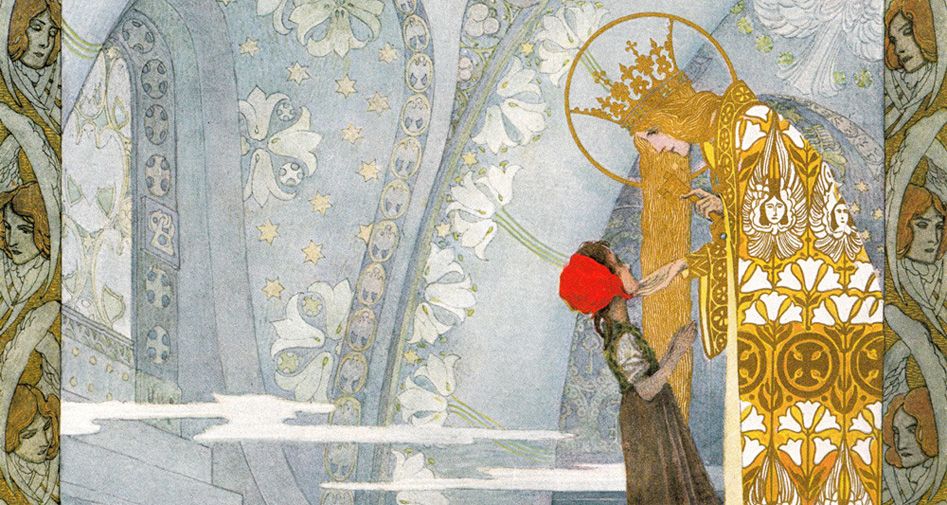
 Facebook
Facebook  Whatsapp
Whatsapp  Messenger
Messenger  Telegram
Telegram Reddit
Reddit














